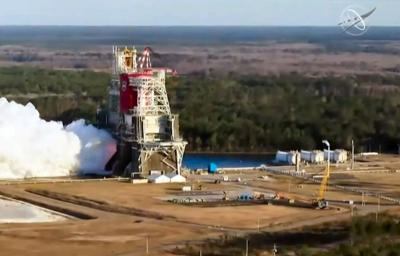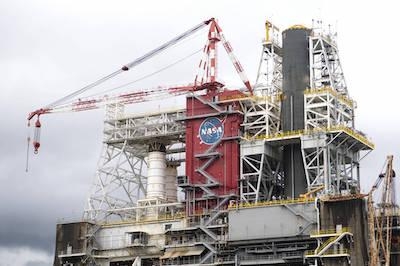Could Happen As Early As The Fourth Week In February
NASA plans to conduct a second Green Run hot fire test as early as the fourth week in February with the Space Launch System (SLS) rocket’s core stage that will launch the Artemis I mission to the Moon. The Green Run is a comprehensive assessment of the rocket’s core stage prior to launching Artemis missions.

While the first hot fire test marked a major milestone for the program with the firing of all four RS-25 engines together for the first time for about a minute, it ended earlier than planned. After evaluating data from the first hot fire and the prior seven Green Run tests, NASA and core stage lead contractor Boeing determined that a second, longer hot fire test should be conducted and would pose minimal risk to the Artemis I core stage while providing valuable data to help certify the core stage for flight.
Inspections showed the core stage hardware, including its engines, and the B-2 test stand are in excellent condition after the first hot fire test, and no major repairs are needed to prepare for a second hot fire test at NASA’s Stennis Space Center in Bay St. Louis, Mississippi.
All SLS rockets use the same core stage design, so a second Green Run hot fire will reduce risk for not only Artemis I, but al

so for all future SLS missions. The Green Run series of tests is designed to certify the core stage design and verify that the new stage is ready for flight. The hot fire test is the final Green Run test and will provide valuable data that minimizes risk for American deep space exploration missions for years to come.
The Green Run team scrutinized data from the first hot fire test and determined that a second hot fire lasting approximately at least four minutes would provide significant data to help verify the core stage is ready for flight. A second hot fire test is planned for about eight minutes to simulate the time amount of time it will take to send the rocket to space following launch. The Green Run wet dress rehearsal and first hot fire test completed several operations:
- transitioning to the automated launch sequence operated by the core stage flight computer and Green Run software,
- completing the terminal countdown sequence that is like the launch countdown
- pressuring the tanks and delivering propellant to the engines and demonstrating performance of the core stage’s main propulsion system, firing the engines at 109 percent power level, and operating the thrust vector control system that steers the engines.

Conducting a second hot fire test will allow the team to repeat operations from the first hot fire test and obtain data on how the core stage and the engines perform over a longer period that simulates more activities during the rocket’s launch and ascent. To prepare for the second hot fire test, the team is continuing to analyze data from the first test, drying and refurbishing the engines, and making minor thermal protection system repairs. They are also updating conservative control logic parameters that resulted in the flight computer ending the first hot fire test earlier than planned. The team has already repaired the faulty electrical harness which resulted in a notification of a Major Component Failure on Engine 4. This instrumentation issue did not affect the engine’s performance and did not contribute to ending the first test early.
After the second hot fire test, it will take about a month to refurbish the core stage and its engines. Then, the Pegasus barge will transport the core stage to NASA’s Kennedy Space Center in Florida where it will be assembled with the other parts of the SLS rocket and the Orion spacecraft being prepared for the Artemis I launch later this year.
 ANN's Daily Aero-Term (04.26.24): DETRESFA (Distress Phrase)
ANN's Daily Aero-Term (04.26.24): DETRESFA (Distress Phrase) ANN's Daily Aero-Linx (04.26.24)
ANN's Daily Aero-Linx (04.26.24) Airborne 04.22.24: Rotor X Worsens, Airport Fees 4 FNB?, USMC Drone Pilot
Airborne 04.22.24: Rotor X Worsens, Airport Fees 4 FNB?, USMC Drone Pilot Airborne 04.24.24: INTEGRAL E, Elixir USA, M700 RVSM
Airborne 04.24.24: INTEGRAL E, Elixir USA, M700 RVSM Airborne-NextGen 04.23.24: UAVOS UVH 170, magni650 Engine, World eVTOL Directory
Airborne-NextGen 04.23.24: UAVOS UVH 170, magni650 Engine, World eVTOL Directory





